When you’re a parent to a baby, toddler, or preschooler, Halloween is one of the best holidays of the year. From the cute little costumes to the fun Halloween crafts and dressing up for the day, Halloween can be lots of fun!
But – as a parent, it’s not always easy. Bringing everyone here and there, staying out past bedtime, and the seemingly endless supply of candy can cause a lot of stress.
And with kids under 4-5 years old, easy access to Halloween treats is often the biggest concern I hear about it – and I get it!
So let’s go over that burning question that every parent has this time of year… “Should my toddler eat Halloween candy at all?”.
We’ll talk about my perspective as both a pediatric dietitian and a mom. Plus, I’ll share what I recommend you try so you can have a clear plan for October 31st!

Table of Contents
And before you even think it, no, I’m not going to tell you about “the switch witch” or selling candy or any other tactic to remove the candy from your house and pretend Halloween never happened. These tactics don’t teach kids anything besides how to avoid the problem. So the next time they reencounter large amounts of candy (like at a birthday party), they’ll have no idea how to manage it.
That’s why there’s actually no reason to fear Halloween night at all (from a feeding perspective at least)! It’s the perfect teaching opportunity for your little eater – so let’s dive into it!
If feeding your toddler causes you a bit of fear and anxiety on a regular basis because mealtimes consist of a lot of pleading, bribing, or negotiating (or you’re scared to end up there), our Feeding Toddlers online course is exactly what you need! Follow our step-by-step plan for preventing and managing picky eating so you can have happy mealtimes with your toddler (without the stress!).
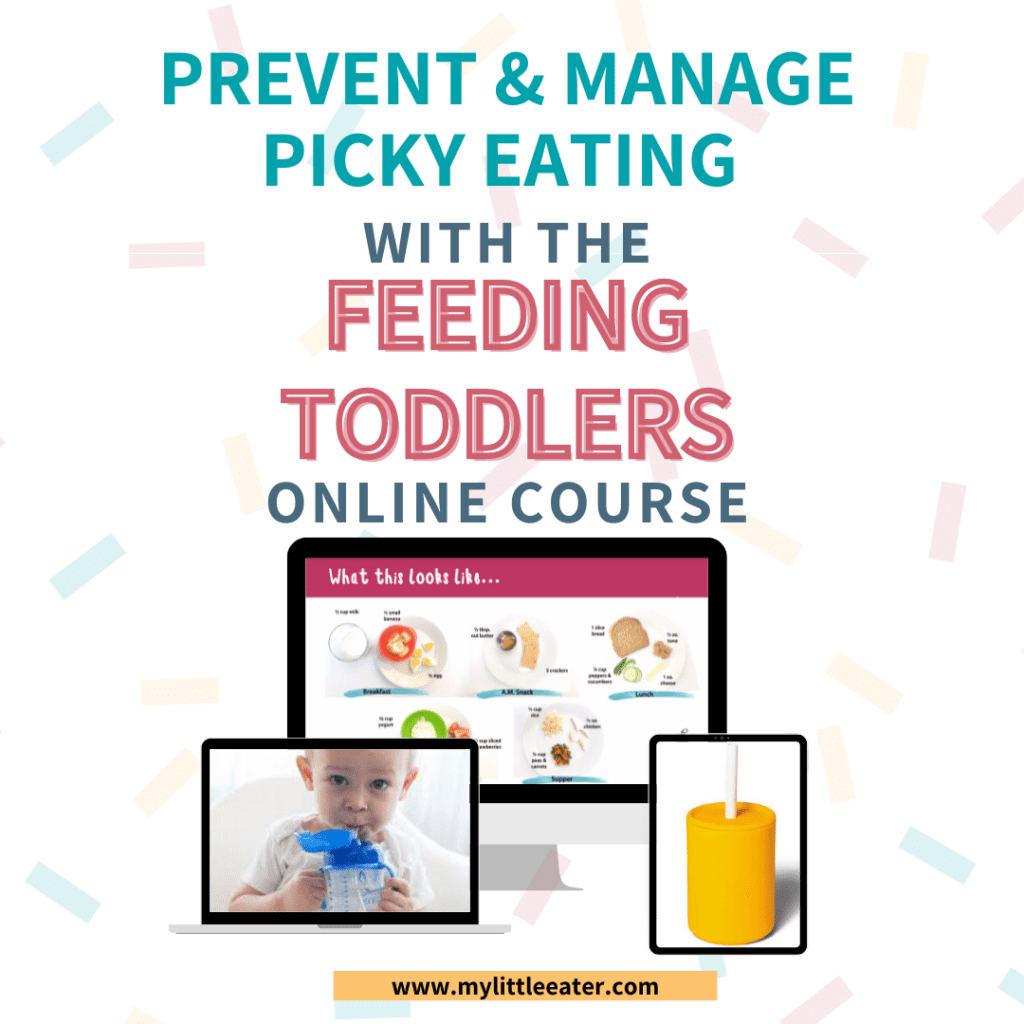
PS. If you prefer to listen instead, check out my podcast episode below!
Why teach your child how to manage Halloween treats?
We need to teach our children how to manage sugar and desserts in a healthy way, versus avoiding or fearing them altogether. We don’t want sugar to take over our child’s diet but we also want to be cautious about not allowing it to show up at all. Having the right attitude about sugar can help prevent candy and treats from becoming an obsession created out of restriction and shame.
To learn more about our strategies, read our blog on how to raise a toddler to have a healthy relationship with sugar. You can also take the in-depth lesson on managing sugar and treats in our Feeding Toddlers online course to develop a strategy that’s right for your family.
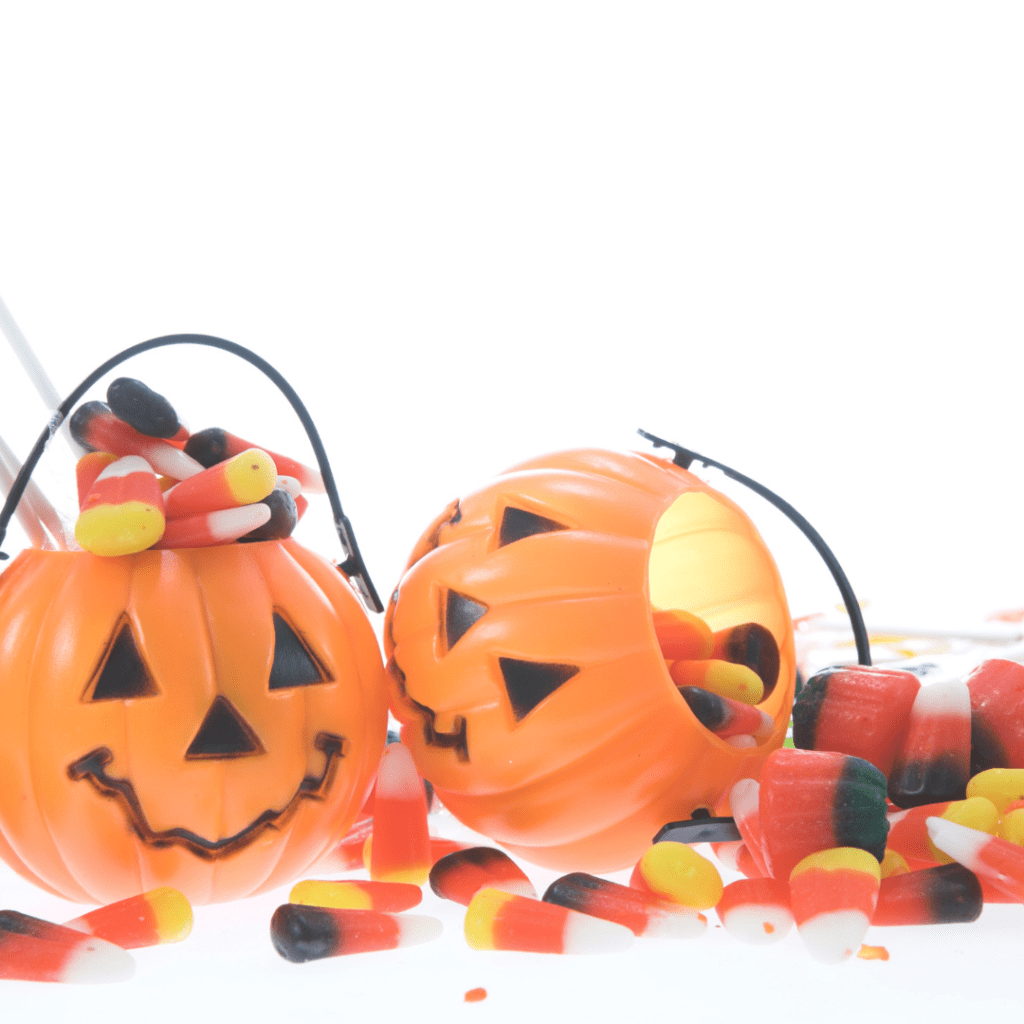
Now, this doesn’t only apply to Halloween of course, but as I mentioned above it’s the perfect opportunity to learn about managing sweets and having a healthy relationship with them. When a child can enjoy Halloween the way that they want to enjoy it (ie. let your child eat candy), it naturally contributes to them having a healthy relationship with sugar and sweets.
Since striking that balance is key, here is my step-by-step plan for Halloween so you can manage your kids’ Halloween candy without putting a damper on the Halloween fun!
6 steps for managing Halloween candy for your toddler or preschooler
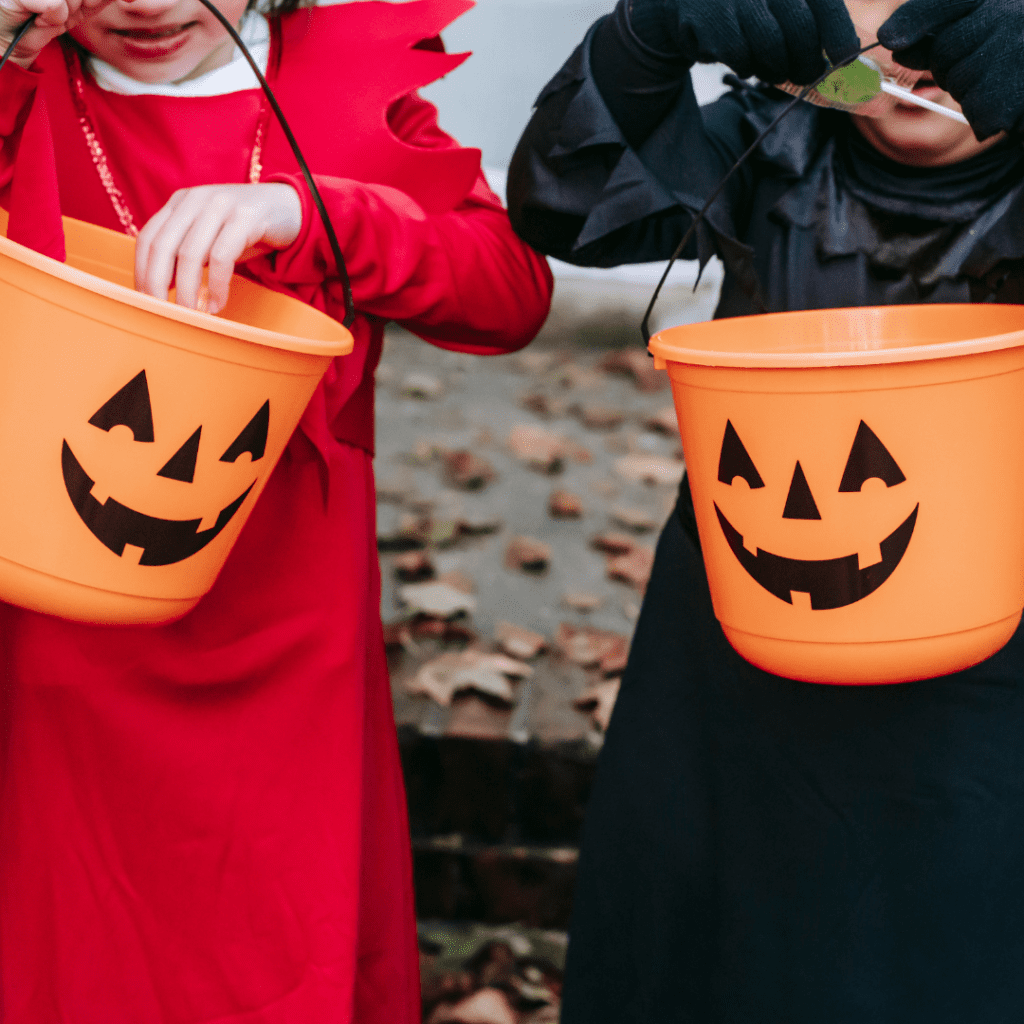
Follow these 6 simple steps to walk away from this season in awe of how your little toddler, preschooler, or school-aged child can be totally cool around Halloween candy, without gorging on it anytime it’s in their possession.
#1 Start the night with a filling supper
Aim to have a filling and nutrient-dense supper with a good source of protein, healthy fat, and fiber before heading out (follow my FFP rule!). Setting your child up to not be hungry before a night full of candy means they will be more likely to enjoy their Halloween treats in moderation. Otherwise, they may gorge on candy because of hunger, resulting in a crazy blood sugar high…and then a crash.
Having your kids eat a combo of protein, healthy fat, and fiber will balance their blood sugar levels out, and help them stay in good spirits long enough to listen to their body and practice mindfulness (more about that coming up!).
#2 Go out and collect your candy with only fun being on the agenda
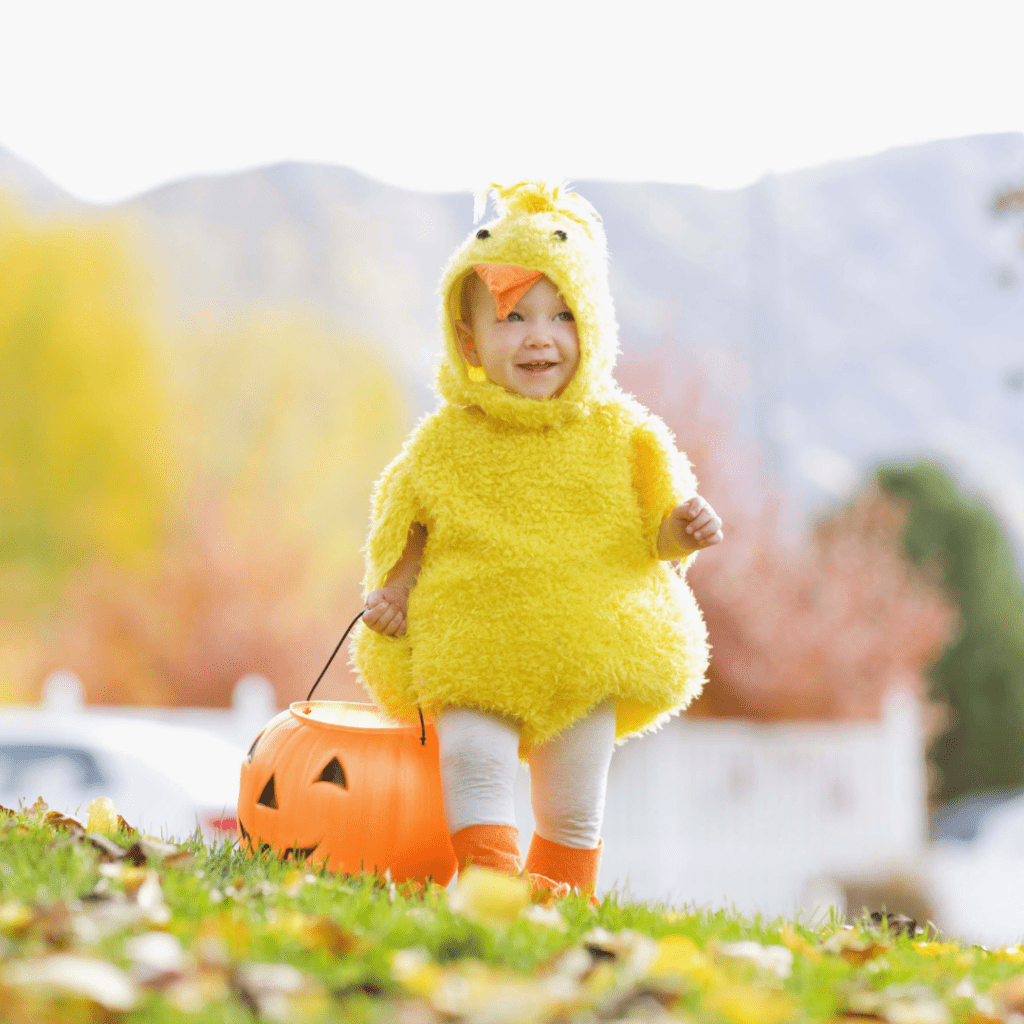
This is the time to purely enjoy the night and the childhood memories they’re forming! Avoid making comments about how much candy there is, how bad it is, how much sugar there is, etc.
Just have a fun time!
Plus, the less emphasis you put on candy, the more success you’ll see in reducing the obsession around it.
#3 Sort the candy with your child by choosing favorites (and for once...encouraging pickiness)
After an initial sifting of the candy loot to ensure safety by checking for choking hazards and if your child has food allergies removing any of those, go ahead and instruct your child to sort the rest of the candy into two piles. A pile of what they think is the best Halloween candy, and a pile for the candy they don’t really care about.
If your toddler or preschooler is experienced with various Halloween candy choices they may already know their favorites. Most have no issue with sorting it into two piles – they’re riding on the high from a night of trick-or-treating and now it’s time to collect the best of their loot! Show them how exciting it is to find a favorite, separate it from the rest, and choose it specifically.
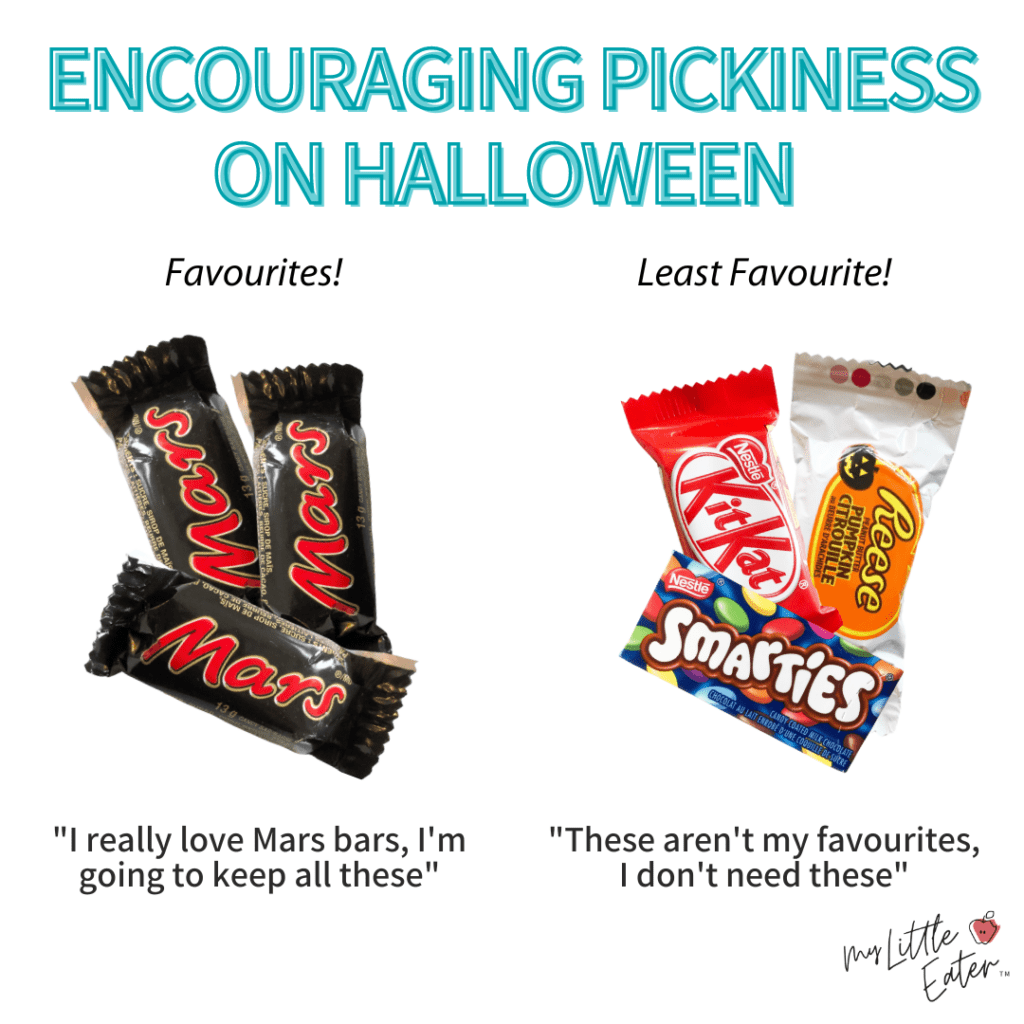
This is step one in showing them how to eat what they love (rather than just because it’s there, or they feel they have to because…well…it’s candy). It’s pretty much the only time we’ll welcome pickiness!
You can lead by example and say something like:
“Mars Bars are my favorite. I’m going to keep all my Mars Bars for sure. But I don’t really like the rockets or Reese’s Peanut Butter Cups. I think I’m going to put them in the other pile”.
What if they put almost everything in the "favorites" pile?
That’s ok! Try not to comment.
This means they’re still very excited, and treasure these foods. Or, they genuinely don’t know yet what their favorites are. Let them start learning what they really like and don’t – which may take a few days, a few weeks, or maybe over a year. As they try and taste different candies for the first few times, they’ll learn what they love and don’t love, especially if you can talk freely with them about it.
Over this time (and when you do this in combination with the other strategies I teach in my Feeding Toddlers course about including desserts and sweets in your child’s diet), the novelty will wear off.
This is much better than you telling them they can’t or shouldn’t have it…which only causes the obsession to linger and grow!
#4 Let them eat as much candy as they want (on night one)
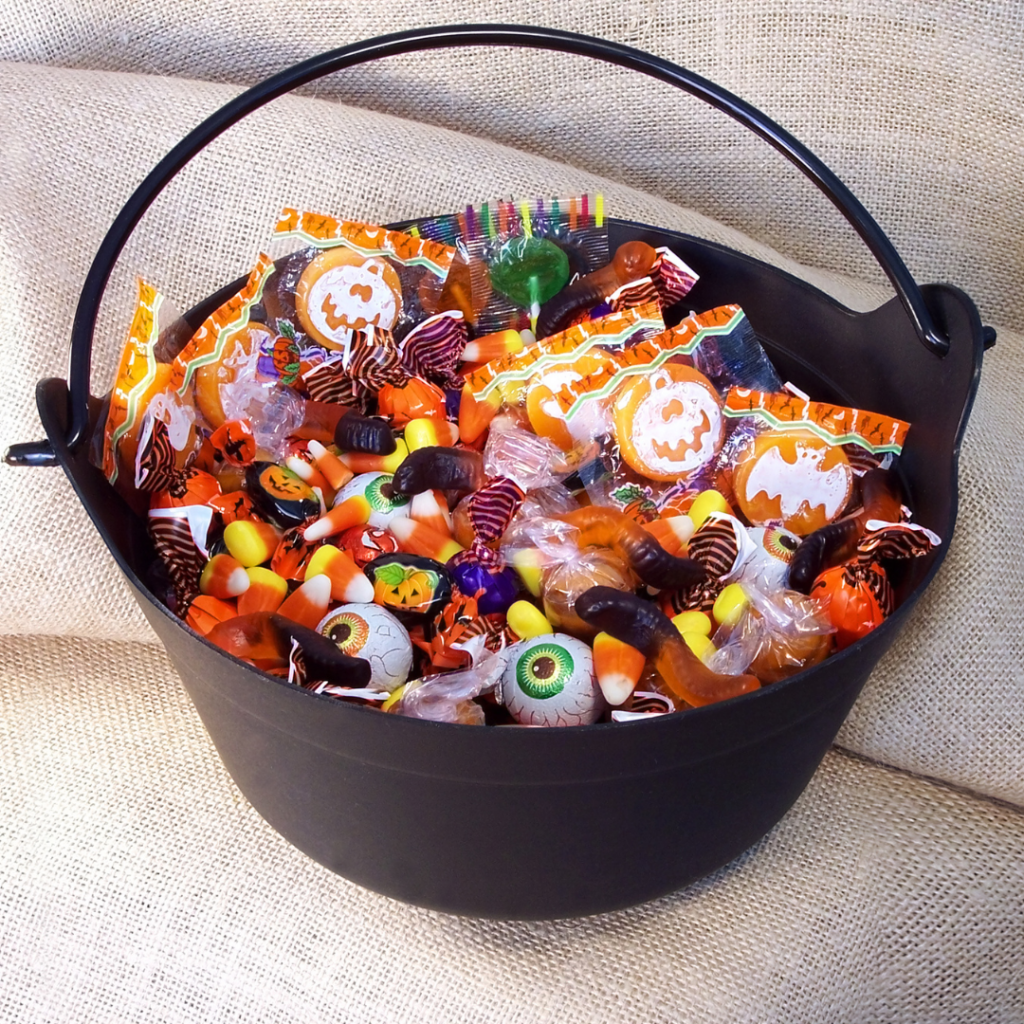
As long as you’ve deemed it appropriate for your toddler to have added sugar/sweets (I recommend waiting until around 2 years old), let your child eat whatever they feel like they want throughout the night.
Yes, as much as they want.
You don’t have to say this to them – but if they ask for candy, you can say yes!
I promise that one night of lots of candy will not ruin them, cause them to be obese, or give them cancer. If you start this and the other strategies I outline in my toddler course from day one, you’ll see that the obsession kids typically have with candy likely hasn’t formed yet. They’re still very good at eating mindfully and slowly and will stop when they’re full.
Most toddlers and preschoolers may take one or two candies, maybe three, and be done with it. They may even take a bite or two and then be distracted by something and never come back to it. The less you fear it, the more you’ll see that you don’t really have much to fear in the first place.
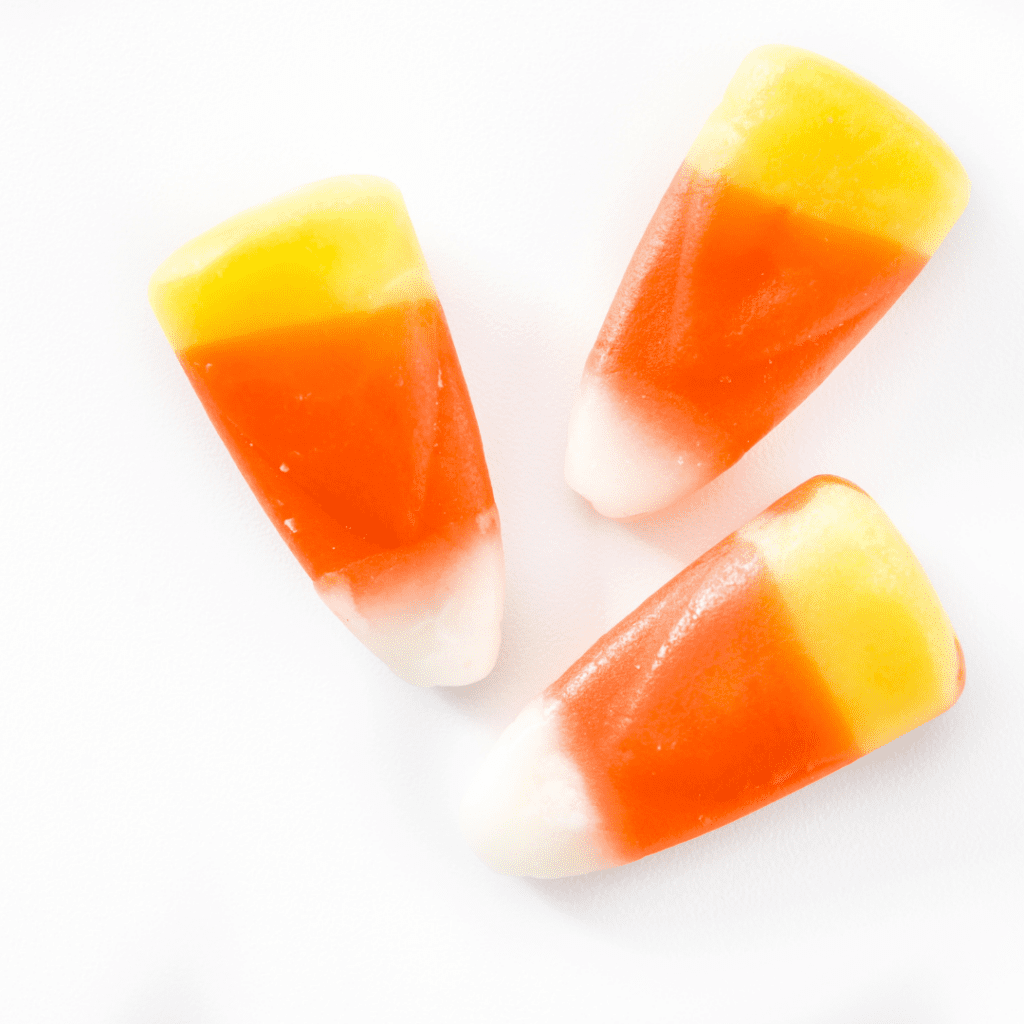
If you feel like they’ve already formed an obsession around candy and sweets, still do the same thing, but just look at the fact that they’re eating more candy than usual as a learning opportunity! It’s important for them to learn what it feels like when they eat a lot of sweets. While they’re eating, avoid commenting overly positive or overly negative things that make them think things like “This is special – I should want more!” or “This is bad – I should eat less”.
Show your little one that candy is a food like any other food. It’s nothing special, nothing to get worked up over or put up on a pedestal. And conversely, it’s nothing to be shamed for when eating. Food (including candy) can be eaten strictly for enjoyment! It doesn’t always have to be tied to nutrition.
Second, kids need to feel what it’s like to eat too much candy (if they do go there). My biggest suggestion is not to come from an “I told you so” perspective, but rather help them observe what they feel and why.
You can say something like “Oh I’m sorry your tummy is hurting. I think maybe having that much candy made it hurt. Let’s practice listening to our body next time and stop before it hurts”. You can read more about teaching mindful eating skills to your toddler here (which can be practiced all year round, with all types of food).
#5 Use this as an opportunity to learn to eat mindfully!
It’s a great time to begin showing your toddler or preschooler how to be mindful when eating! Instead of teaching kids to obsess over it and eat in a hurry or eat candy when they’re full (because it’s candy…it’s there..and we HAVE to eat it…duh).
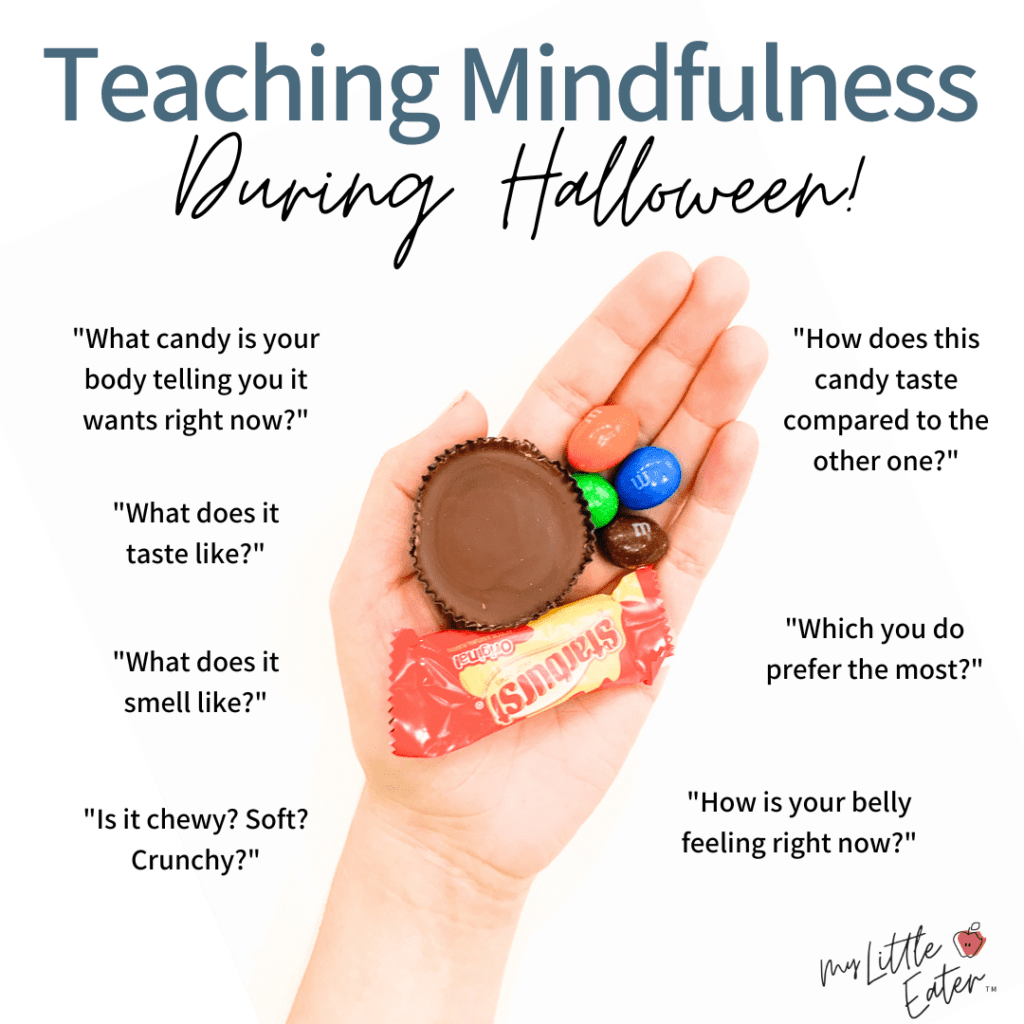
Let’s instead choose to teach them to consciously pick the candy they’re actually going to enjoy the most, and show them how to enjoy it fully!
Raise your hand if you want to avoid this:
Your child: “Ooh candy corn and chocolate bars!”
They take whatever they see and proceed to stuff as much in as they can. This leads them to realize that the experience is over and the chocolate candy is already gone. They finish feeling unsatisfied and wanting more candy.
VS
Your child: “Ooh candy!”
You: “Which candy does your body feel like it wants to eat the most today?”
Your child: “Reese’s peanut butter cups!”
You: “Great! Take a slow bite and tell me how it feels in your mouth. You can close your eyes if you want! Now, tell me what you like about this one. Why did you choose it?”
Your child: “Mmm… mine smells like the peanut butter we put on toast in the morning…my belly is starting to feel full”
You: “You can stop when you’re full and we can have more tomorrow at snack time.”
They finish feeling satisfied and can move on to the next activity.
Keep the experience positive, slow the body down, and help your toddler be in tune with their body!
TBH…this should be how we approach all foods! But around Halloween, fears about the extreme sugar rush and obsession with candy are so strong, that it’s easier to have motivation to start teaching mindfulness to your child!
#6 Resume your regular sweets/treats strategy every day after trick-or-treating
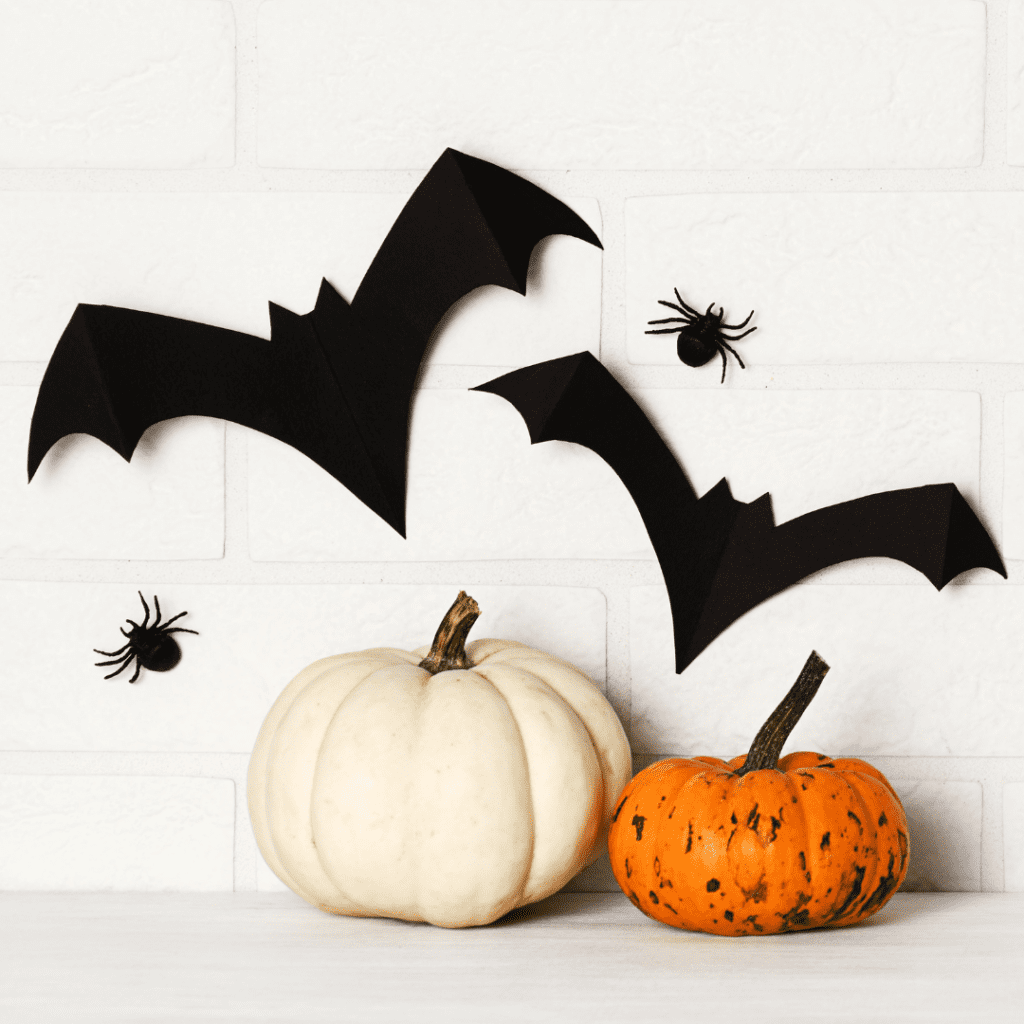
After night one, put the candy out of sight, maybe in a cupboard somewhere, and go back to practicing the strategies outlined in my Feeding Toddlers course. Focus on serving the candy as you see fit, within your overall desserts/sweets strategy. Always offer it alongside a meal or snack so that way it’s treated like any other food. You want it to be a small portion on the plate that’s offered amongst a variety of other nutritious food options. Always let it be you who chooses when to offer it rather than giving it anytime your child asks for it. This is following in line with the feeding strategy I’m always preaching about – the Division of Responsibility.
What if they ask for it outside of planned meals or snacks?
Here’s what I want you to say if your toddler asks for Halloween candy and it’s not a scheduled snack or mealtime yet: “We’ll be having candy with supper today! Right now we’re having x,y,z.”
Be sure to let them know that it will be coming around and that it’s planned on your menu. This shows them that it’s not forbidden and it’s not going to disappear forever after Halloween night. You don’t want them to feel that it’s too scarce and never going to show up again. That’s only going to feed into the obsession and may make them think that mom or dad will never serve candy so they’ve got to eat as much as they can when it’s there (and maybe even sneak it in!). If they feel confident that you’ll offer candy once a week, a few times a week, or maybe even once a day (based on your individual sweets strategy from the Feeding Toddlers course) they can relax about it and trust that it will come around.
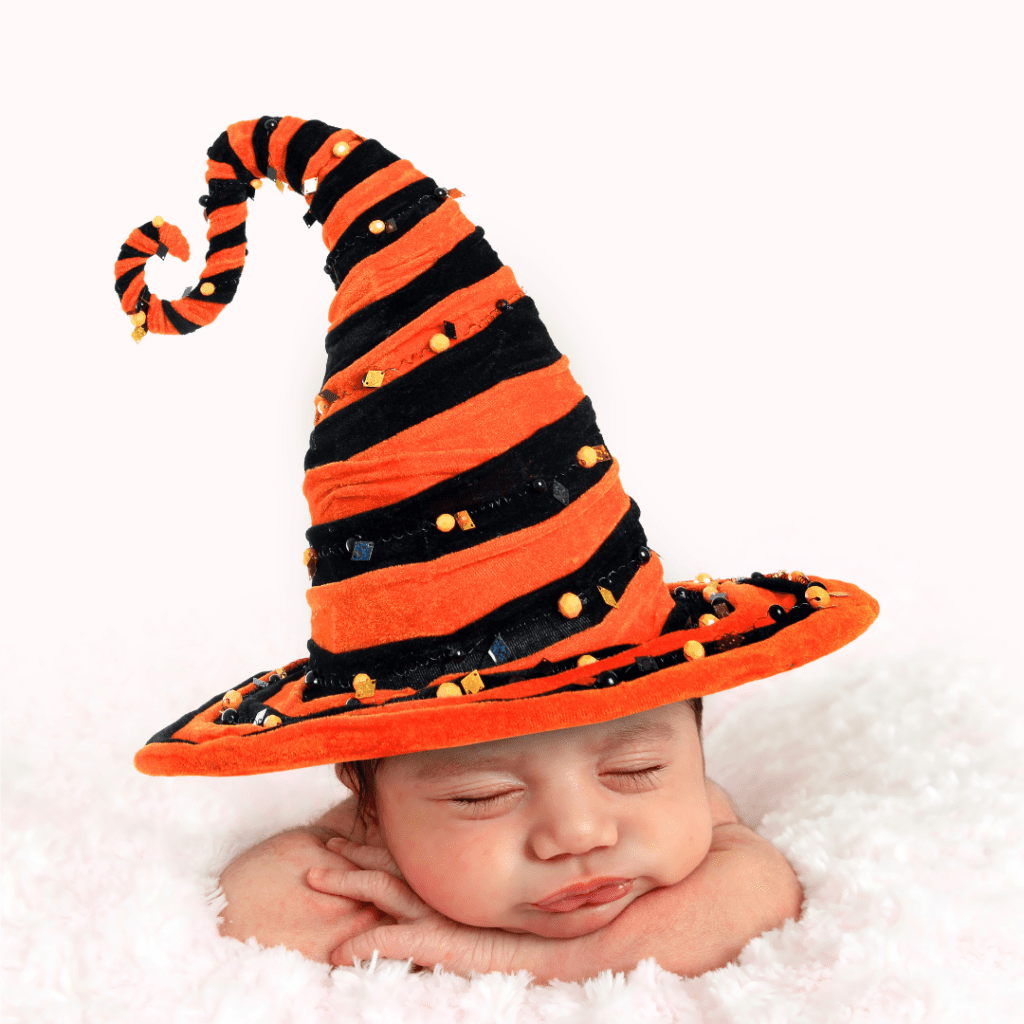
Halloween candy lasts forever...can I throw some out?
Many families find the idea of having all of that candy in the house stresses them out…and I get it! But I want you to think of it this way…since you are in control of what and when to serve candy (as with any other type of food), it’s never going to be a “free-for-all” with candy after that first night. You can have the biggest stash in the world up in a cupboard, but you’re still only pulling it out strategically once a day, every couple of days, or however often you’ve decided works best within your sweets and dessert strategy. In between, it’s out of sight for your kids! The novelty will eventually wear off, but by not treating it as a restricted food that never comes out, it removes the idea that candy is forbidden.
If it’s taking a long time to get through the candy and you’re coming up on the next season that’s often heavy with treats, yes you can throw some out. Discreetly, without your kids involved. It doesn’t need to be a lesson on what too much candy looks like or anything like that. Simply put, candy can’t last forever, you need to make space for new things to come in and that’s it!
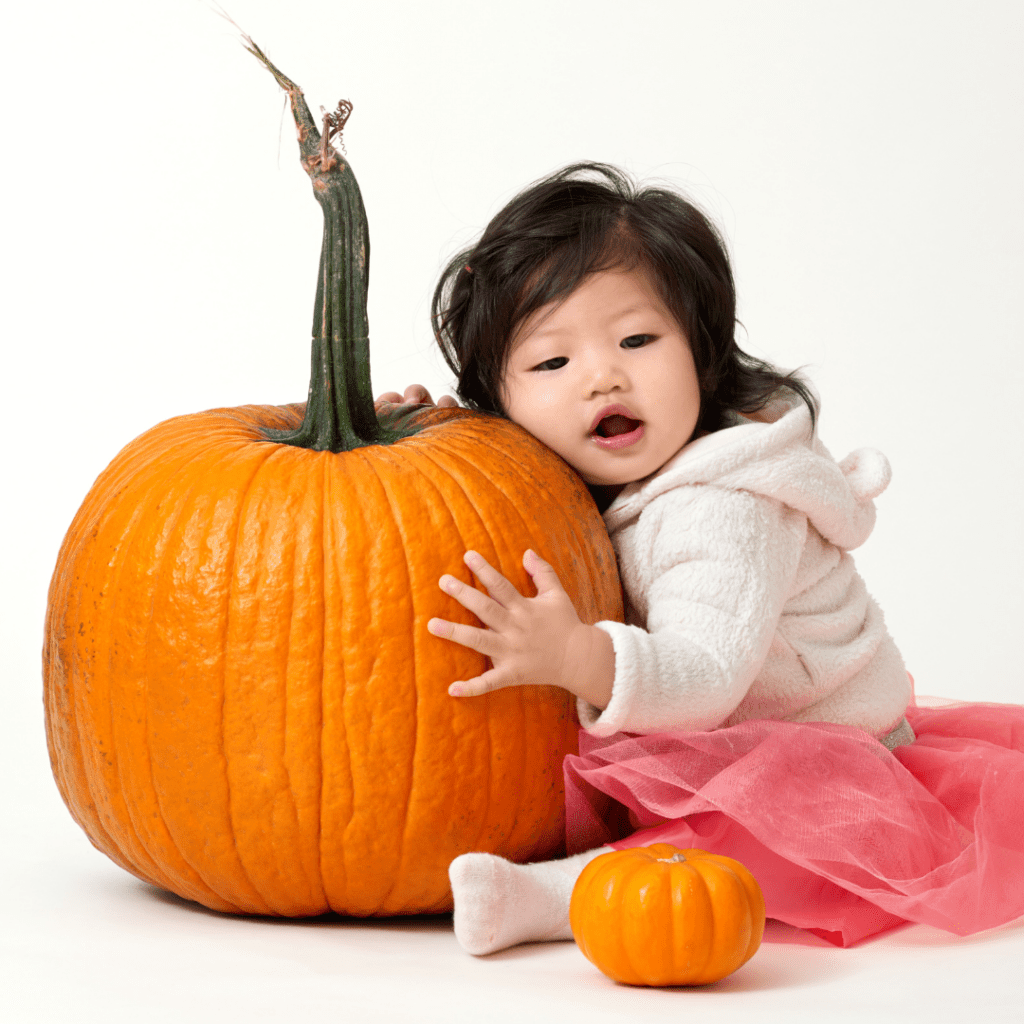
If you want to learn my in-depth teachings on how to healthily feed toddlers and preschoolers while preventing or managing picky eating, enroll in our Feeding Toddlers online course now! Follow our step-by-step plan to feel confident that you’re setting your toddler up to have a healthy relationship with food.

Is this helpful? Pin it to save for later!
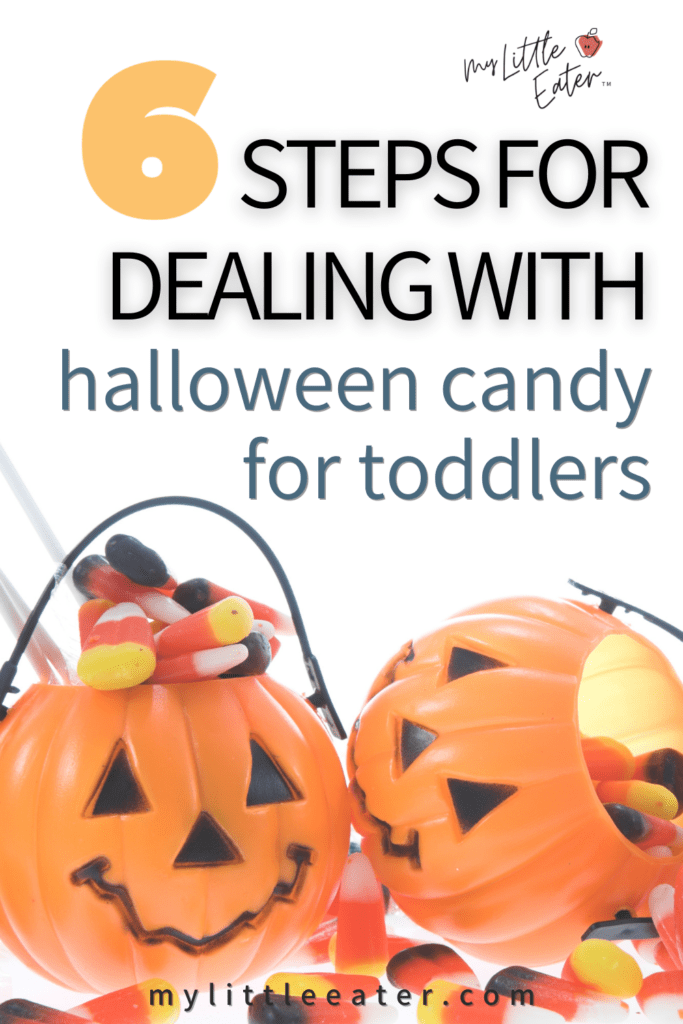

about the author
EDWENA KENNEDY, RD
Founder and lead Registered Pediatric Dietitian at My Little Eater Inc., creator of The Texture Timeline™, and mom of two picky-turned-adventurous eaters.

about the author
EDWENA KENNEDY, RD
Founder and lead Registered Pediatric Dietitian at My Little Eater Inc., creator of The Texture Timeline™, and mom of two picky-turned-adventurous eaters.








